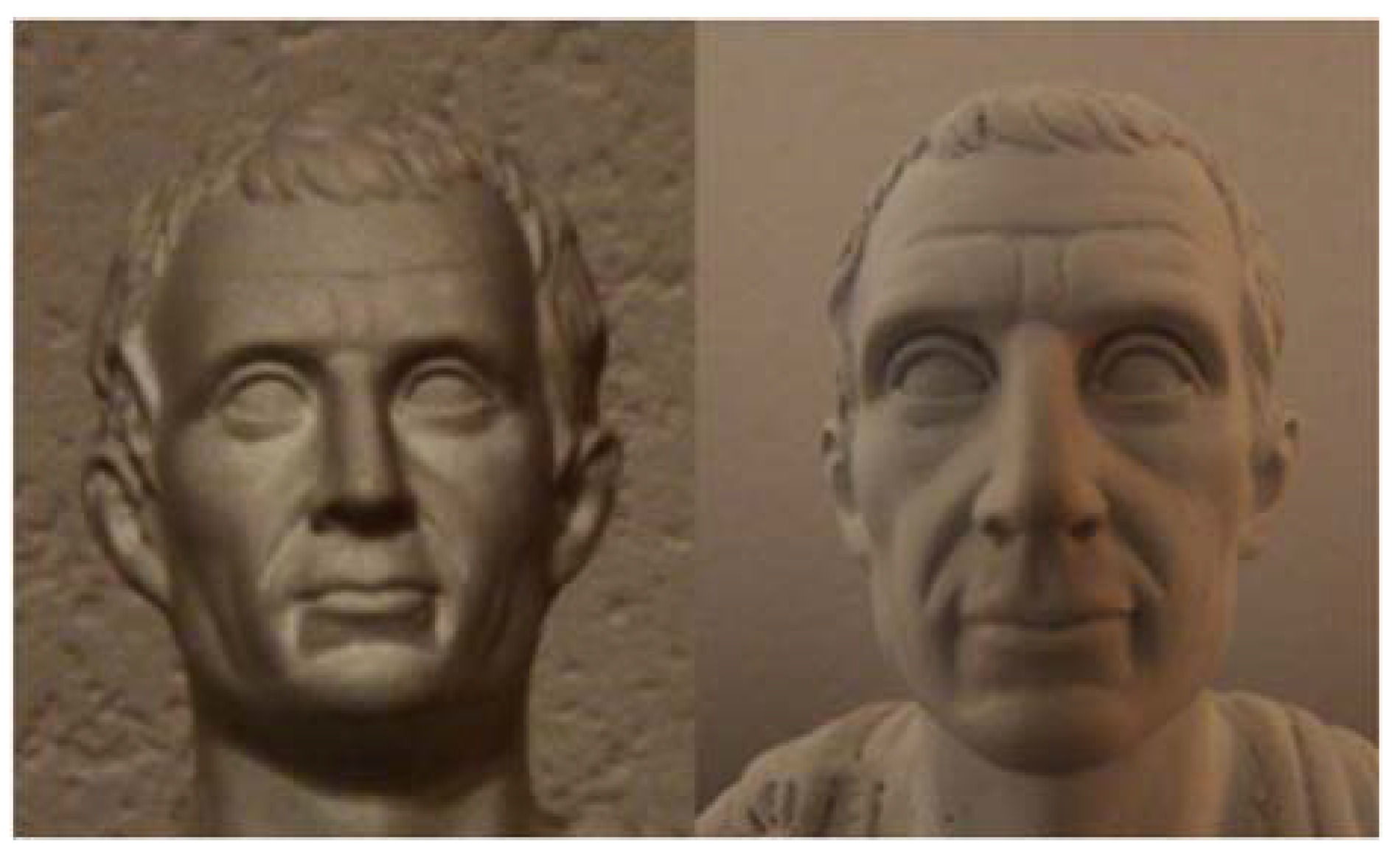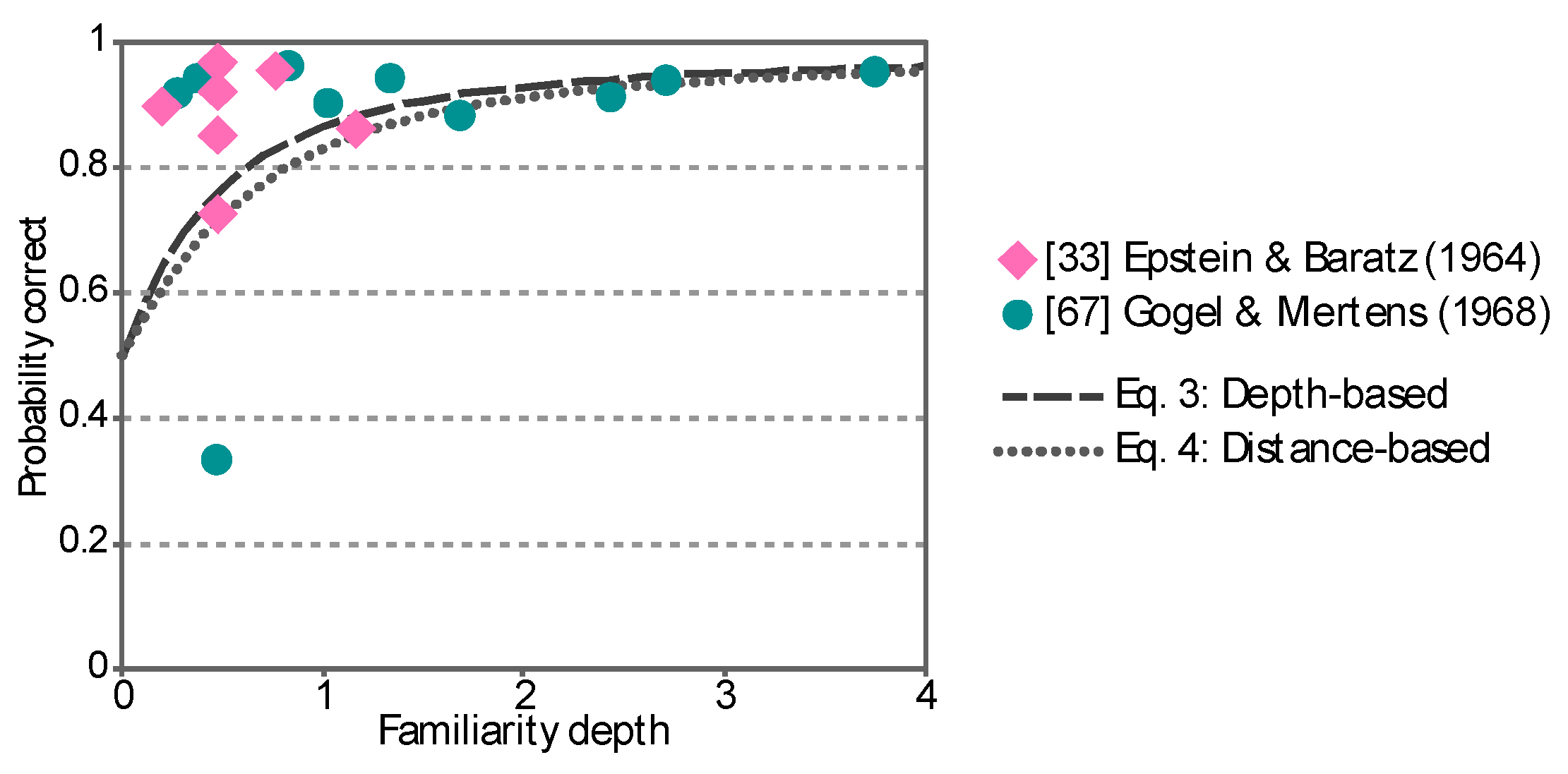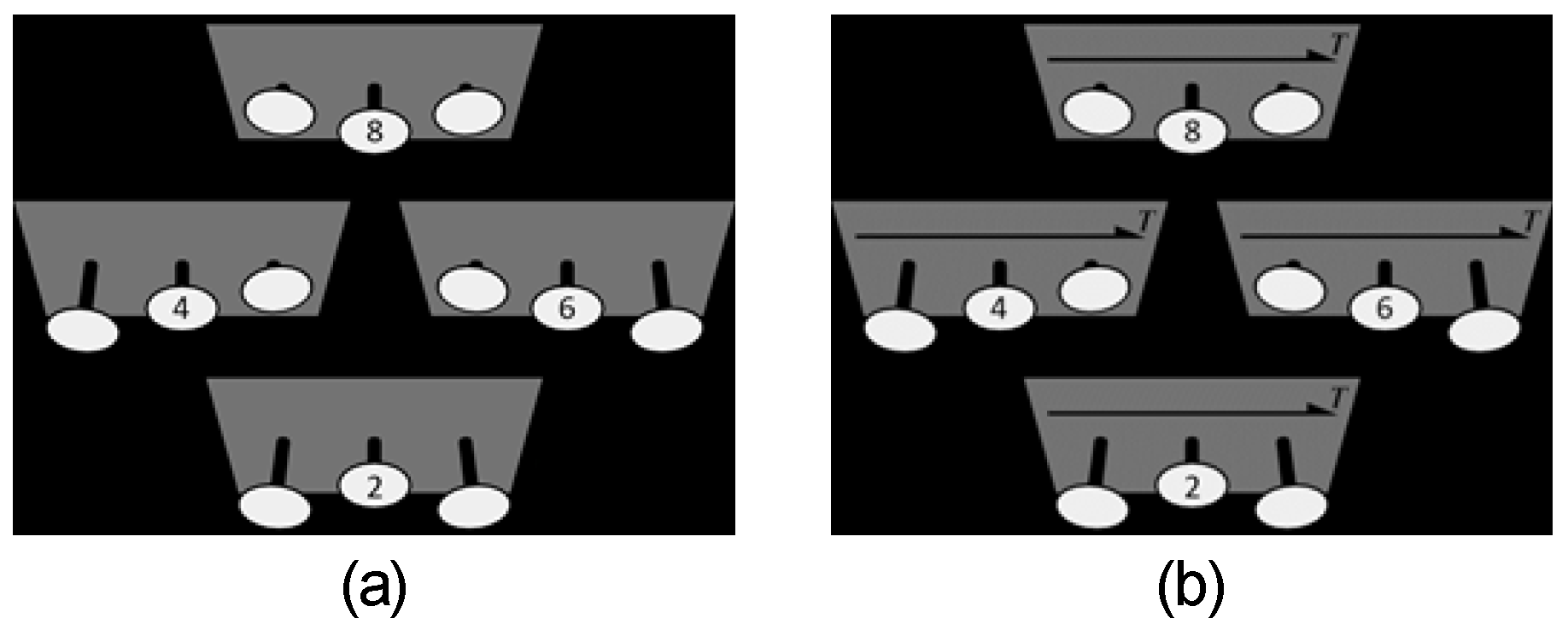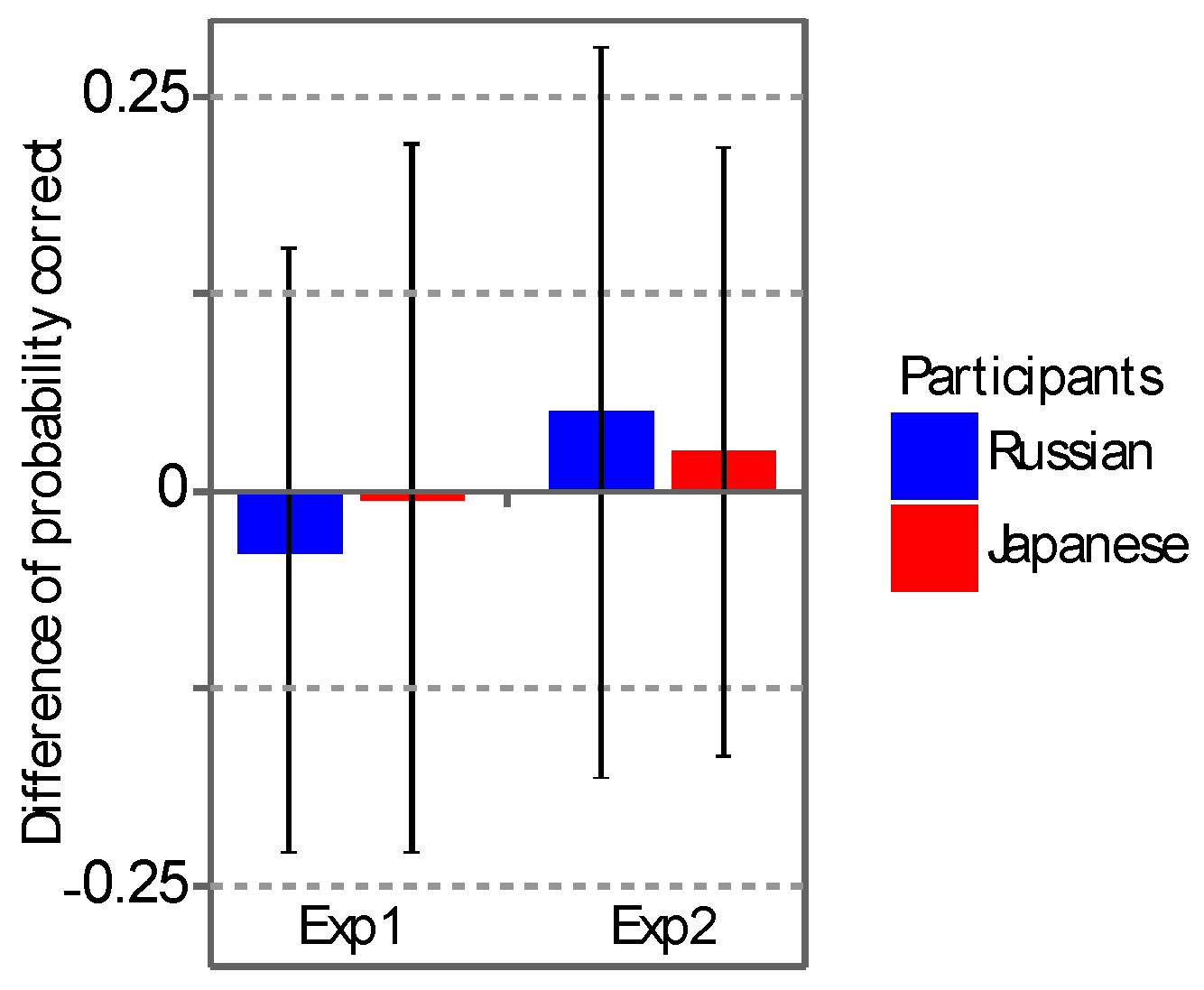Examining the Role of Familiarity in the Perception of Depth
Abstract
1. Introduction
2. Meta-Analysis
2.1. Distance from Familiarity
2.2. Depth from Familiarity
2.3. Comparing Distance and Depth from Familiarity
3. Psychophysical Experiments
3.1. Methods
3.1.1. Participants
3.1.2. Apparatus
3.1.3. Stimuli
3.1.4. Procedure
3.1.5. Power-Analysis
3.2. Results
4. Discussion
Supplementary Materials
Author Contributions
Funding
Conflicts of Interest
References
- Pizlo, Z. 3D Shape: Its Unique Place in Visual Perception; MIT Press: Cambridge, MA, USA, 2008. [Google Scholar]
- Pizlo, Z.; Li, Y.; Sawada, T.; Steinman, R.M. Making a Machine That Sees Like US; Oxford University Press: New York, NY, USA, 2014. [Google Scholar]
- Berkeley, G. An Essay Towards a New Theory of Vision, 2nd ed.; Ireland Publisher: Dublin, Ireland, 1709. [Google Scholar]
- Balcetis, E.; Dunning, D. Wishful seeing: More desired objects are seen as closer. Psychol. Sci. 2010, 21, 147–152. [Google Scholar] [CrossRef] [PubMed]
- Dion, K.L.; Dion, K.K. The honi phenomenon revisited: Factors underlying the resistance fo perceptual distortion of one’s partner. J. Personal. Soc. Psychol. 1976, 33, 170–177. [Google Scholar] [CrossRef]
- Francis, G. The same old new look: Publication bias in a study of wishful seeing. i-Perception 2012, 3, 176–178. [Google Scholar] [CrossRef]
- Ong, J.; Luck, W.J.; Olson, H.A. Reliability, sex difference, and honi phenomenon in a distorted room. Percept. Mot. Ski. 1980, 51, 956–958. [Google Scholar] [CrossRef] [PubMed]
- Wittreich, W.J. The Honi phenomenon: A case of selective perceptual distortion. J. Abnorm. Psychol. Soc. Psychol. 1952, 47, 705–712. [Google Scholar] [CrossRef]
- Gogel, W.C. Size cue to visually perceived distance. Psychol. Bull. 1964, 62, 217–235. [Google Scholar] [CrossRef]
- Chandler, D.; Munday, R. Pictorial Depth Cues. In A Dictionary of Media and Communication; Chandler, D., Munday, R., Eds.; Oxford University Press: Oxford, UK, 2011; Available online: https://www.oxfordreference.com/view/10.1093/oi/authority.20110803100326349 (accessed on 31 January 2020).
- Howard, I.P. Perceiving in Depth. In Other mechanisms of Depth Perception; Oxford University Press: Oxford, UK, 2012. [Google Scholar]
- Sedgwick, H.A. Space perception. In Handbook of Perception and Human Performance, Volume 1: Sensory Processes and Perception; Boff, K.R., Kaufman, L.I., Thomas, J.P., Eds.; Wiley: New York, NY, USA, 1986; pp. 1–57. [Google Scholar]
- Depth Perception [Wiki on the Internet]. Wikimedia Foundation: St. Petersburg, FL, USA. Available online: https://en.wikipedia.org/wiki/Depth_perception (accessed on 24 September 2019).
- Goldstein, E.B.; Brockmole, J. Sensation & Perception, 10th ed.; Cengage Learning: Boston, MA, USA, 2016. [Google Scholar]
- Schwartz, B.L.; Krantz, J.H. Sensation & Perception, 2nd ed.; SAGE: Thousand Oaks, CA, USA, 2017. [Google Scholar]
- Firestone, C.; Scholl, B.J. Cognition does not affect perception: Evaluating the evidence for top-down effects. Behav. Brain Sci. 2016, e229. [Google Scholar] [CrossRef]
- Bruner, J.S. The functions of perceiving: New look retrospect. In Beyond the Information Given: Studies in the Psychology of Knowing; Bruner, J.S., Ed.; W. W. Norton & Company: New York, NY, USA, 1973; pp. 114–124. [Google Scholar]
- Durgin, F.H.; Li, Z. Why do hills look so steep? In Oxford Compendium of Visual Illusions; Shapiro, A.G., Todorović, D., Eds.; Oxford University Press: New York, NY, USA, 2017; pp. 190–197. [Google Scholar]
- Merriman, W.E.; Moore, Z.; Granrud, C.E. Children’s strategic compensation for size underconstancy: Dependence on distance and relation to reasoning ability. Vis. Cogn. 2010, 18, 296–319. [Google Scholar] [CrossRef]
- Granrud, C.E. Judging the size of a distant object: Strategy use by children and adults. In Visual Experience: Sensation, Cognition, and Constancy; Hatfield, G., Allred, S., Eds.; Oxford University Press: Oxford, UK, 2012; pp. 13–34. [Google Scholar]
- Gogel, W.C. An indirect method of measuring perceived distance from familiar size. Percept. Psychophys. 1976, 20, 419–429. [Google Scholar] [CrossRef]
- Hands, P.; Khushu, A.; Read, J.C.A. Interaction between size and disparity cues in distance judgements. In Proceedings of the International Conference on 3D Imaging (IC3D), Liege, Belgium, 9–10 December 2014; Springer International Publishing: Midtown Manhattan, NY, USA, 2014; pp. 1–5. [Google Scholar] [CrossRef]
- Martín, A.; Chambeaud, J.G.; Barraza, J.F. The effect of object familiarity on the perception of motion. J. Exp. Psychol. Hum. Percept. Perform. 2015, 41, 283–288. [Google Scholar] [CrossRef]
- Martín, A.; Décima, A.P.; Barraza, J.F. Perception of speed, distance, and TTC of familiar objects. Psychol. Neurosci. 2017, 10, 261–272. [Google Scholar] [CrossRef]
- Predebon, J. The role of instructions and familiar size in absolute judgments of size and distance. Percept. Psychophys. 1992, 51, 344–354. [Google Scholar] [CrossRef] [PubMed]
- Higashiyama, A. The effects of familiar size on judgments of size and distance: An interaction of viewing attitude with spatial cues. Percept. Psychophys. 1984, 35, 305–312. [Google Scholar] [CrossRef] [PubMed]
- Baird, J.C. Retinal and assumed size cues as determinants of size and distance perception. J. Exp. Psychol. 1963, 66, 155–162. [Google Scholar] [CrossRef] [PubMed]
- Durgin, F.H.; Baird, J.A.; Greenburg, M.; Russell, R.; Shaughnessy, K.; Waymouth, S. Who is being deceived? The experimental demands of wearing a backpack. Psychon. Bull. Rev. 2009, 16, 964–969. [Google Scholar] [CrossRef]
- Durgin, F.H.; Klein, B.; Spiegel, A.; Strawser, C.J.; Williams, M. The social psychology of perception experiments: Hills, backpacks, glucose and the problem of generalizability. J. Exp. Psychol. Hum. Percept. Perform. 2012, 38, 1582–1595. [Google Scholar] [CrossRef]
- Predebon, G.M.; Wenderoth, P.M.; Curthoys, I.A. The effects of instructions and distance on judgments of off-size familiar objects under natural viewing conditions. Am. J. Psychol. 1974, 87, 425–439. [Google Scholar] [CrossRef]
- Woods, A.J.; Philbeck, J.W.; Danoff, J.V. The various perceptions of distance: An alternative view of how effort affects distance judgments. J. Exp. Psychol. Hum. Percept. Perform. 2009, 35, 1104–1117. [Google Scholar] [CrossRef]
- Burnham, D.K. Apparent relative size in the judgement of apparent distance. Perception 1983, 12, 683–700. [Google Scholar] [CrossRef]
- Epstein, W.; Baratz, S.S. Relative size in isolation as a stimulus for relative perceived distance. J. Exp. Psychol. 1964, 67, 507–513. [Google Scholar] [CrossRef]
- Epstein, W.; Franklin, S. Some conditions of the effect of relative size on perceived relative distance. Am. J. Psychol. 1965, 78, 466–470. [Google Scholar] [CrossRef]
- Brown, J.M.; Weisstein, N. A spatial frequency effect on perceived depth. Percept. Psychophys. 1988, 44, 157–166. [Google Scholar] [CrossRef] [PubMed]
- Marshall, J.A.; Ariely, D.; Rolland, J.P. Occlusion edge blur: A cue to relative visual depth. J. Opt. Soc. Am. A 1996, 13, 681–988. [Google Scholar] [CrossRef] [PubMed]
- Mather, G. The use of image blur as a depth cue. Perception 1997, 26, 1147–1158. [Google Scholar] [CrossRef] [PubMed]
- O’shea, R.P.; Blackburn, S.G.; Ono, H. Contrast as a depth cue. Vis. Res. 1994, 34, 1595–1604. [Google Scholar] [CrossRef]
- O’shea, R.P.; Sekuler, R. Blur and contrast as pictorial depth cues. Perception 1997, 26, 599–612. [Google Scholar] [CrossRef]
- Tai, N.; Inanici, M. Luminance contrast as depth cue: Investigation and design applications. Comput. Des. Appl. 2012, 9, 691–705. [Google Scholar] [CrossRef]
- Egusa, H. Effects of brightness, hue, and saturation on perceived depth between adjacent regions in the visual field. Perception 1983, 12, 167–175. [Google Scholar] [CrossRef]
- Guibal, C.R.C.; Dresp, B. Interaction of color and geometric cues in depth perception: When does red mean near? Psychol. Res. 2004, 69, 30–40. [Google Scholar] [CrossRef]
- Sundet, J.M. Effects of colour on perceived depth. Scand. J. Psychol. 1978, 19, 133–143. [Google Scholar] [CrossRef]
- Burge, J.; Peterson, M.A.; Palmer, S.E. Ordinal configural cues combine with metric disparity in depth perception. J. Vis. 2005, 5, 535–542. [Google Scholar] [CrossRef] [PubMed]
- Palmer, S.E.; Brooks, J.L. Edge-region grouping in figure-ground organization and depth perception. J. Exp. Psychol. Hum. Percept. Perform. 2008, 34, 1353–1371. [Google Scholar] [CrossRef]
- Predebon, J.; Woolley, J.S. The familiar-size cue to depth under reduced-cue viewing conditions. Perception 1994, 23, 1301–1312. [Google Scholar] [CrossRef] [PubMed]
- Hochberg, C.B.; Hochberg, J.E. Familiar size and the perception of depth. J. Psychol. 1952, 34, 107–114. [Google Scholar] [CrossRef]
- Hochberg, C.B.; Hochberg, J.E. Familiar size and subception in perceived depth. J. Psychol. 1953, 36, 341–345. [Google Scholar] [CrossRef]
- Hochberg, J.E.; McAlister, E. Relative size vs. familiar size in the perception of represented depth. Am. J. Psychol. 1955, 68, 294–296. [Google Scholar] [CrossRef]
- Mershon, D.H.; Gogel, V.C. Failure of familiar size to determine a metric for visually perceived distance. Percept. Psychophys. 1975, 17, 101–106. [Google Scholar] [CrossRef][Green Version]
- Gogel, W.C. The absolute and relative size cues to distance. Am. J. Psychol. 1969, 82, 228–234. [Google Scholar] [CrossRef]
- Gogel, W.C.; Hartman, B.O.; Harker, G.S. The retinal size of a familiar object as a determiner of apparent distance. Psychol. Monogr. Gen. Appl. 1957, 71, 1–16. [Google Scholar] [CrossRef]
- Gogel, W.C.; Mertens, H.W. Perceived size and distance of familiar objects. Percept. Mot. Ski. 1967, 25, 213–225. [Google Scholar] [CrossRef]
- Ittelson, W.H.; Ames, A., Jr. Accommodation, convergence, and their relation to apparent distance. J. Psychol. 1950, 30, 43–62. [Google Scholar] [CrossRef]
- Fitzpatrick, V.; Pasnak, R.; Tyer, Z.E. The effect of familiar size at familiar distances. Perception 1982, 11, 85–91. [Google Scholar] [CrossRef] [PubMed]
- Predebon, J. Role of familiar size in spatial judgments under natural viewing conditions. Percept. Mot. Ski. 1979, 48, 171–176. [Google Scholar] [CrossRef] [PubMed]
- Predebon, J. Familiar size and judgments of distance. Bull. Psychon. Soc. 1987, 25, 244–246. [Google Scholar] [CrossRef]
- Predebon, J. Relative distance judgments of familiar and unfamiliar objects viewed under representatively natural conditions. Percept. Psychophys. 1990, 47, 342–348. [Google Scholar] [CrossRef]
- Predebon, J. The familiar-size cue to distance and stereoscopic depth perception. Perception 1993, 22, 985–995. [Google Scholar] [CrossRef]
- Hosking, S.G.; Crassini, B. The effects of familiar size and object trajectories on time-to-contact judgements. Exp. Brain Res. 2010, 203, 541–552. [Google Scholar] [CrossRef] [PubMed]
- Ono, H. Apparent distance as a function of familiar size. J. Exp. Psychol. 1969, 79, 109–115. [Google Scholar] [CrossRef] [PubMed]
- Pirenne, M.H. Optics, Painting & Photography; Cambridge University Press: London, UK, 1970. [Google Scholar]
- Epstein, W. The influence of assumed size on apparent distance. Am. J. Psychol. 1963, 76, 257–265. [Google Scholar] [CrossRef]
- Epstein, W. Nonrelational judgments of size and distance. Am. J. Psychol. 1965, 78, 120–123. [Google Scholar] [CrossRef] [PubMed]
- Gogel, W.C. The effect of object familiarity on the perception of size and distance. Q. J. Exp. Psychol. 1969, 21, 239–247. [Google Scholar] [CrossRef] [PubMed]
- Gogel, W.C. The sensing of retinal size. Vis. Res. 1969, 9, 1079–1094. [Google Scholar] [CrossRef]
- Gogel, W.C.; Mertens, H.W. Perceived depth between familiar objects. J. Exp. Psychol. 1968, 77, 206–211. [Google Scholar] [CrossRef] [PubMed]
- Ittelson, W.H. Size as a cue to distance: Static localization. Am. J. Psychol. 1951, 64, 54–67. [Google Scholar] [CrossRef] [PubMed]
- Epstein, W. The known-size-apparent-distance hypothesis. Am. J. Psychol. 1961, 74, 333–346. [Google Scholar] [CrossRef]
- Gogel, W.C.; Da Silva, J.A. Familiar size and the theory of off-sized perceptions. Percept. Psychophys. 1987, 41, 318–328. [Google Scholar] [CrossRef]
- McKennell, A.C. Visual size and familiar size: Individual differences. Br. J. Psychol. 1960, 51, 27–35. [Google Scholar] [CrossRef]
- DeLucia, P.R. Image size and instructions in the perception of depth. Q. J. Exp. Psychol. 2005, 58A, 865–886. [Google Scholar] [CrossRef]
- Peirce, J.W.; Gray, J.R.; Simpson, S.; MacAskill, M.; Höchenberger, R.; Sogo, H.; Kastman, E.; Lindelov, J.K. PsychoPy2: Experiments in behavior made easy. Behav. Res. Methods 2019, 51, 195–203. [Google Scholar] [CrossRef]
- Neter, J.; Kutner, M.H.; Nachtsheim, C.J.; Wasserman, W. Applied Linear Statistical Models, 4th ed.; McGraw-Hill: Boston, MA, USA, 1996. [Google Scholar]
- Rouder, J.N.; Speckman, P.L.; Sun, D.; Morey, R.D.; Iverson, G. Bayesian t tests for accepting and rejecting the null hypothesis. Psychon. Bull. Rev. 2009, 16, 225–237. [Google Scholar] [CrossRef]
- Wetzels, R.; Matzke, D.; Lee, M.D.; Rouder, J.N.; Iverson, G.J.; Wagenmakers, E. Statistical evidence in experimental psychology: An empirical comparison using 855 t tests. Perspect. Psychol. Sci. 2011, 6, 291–298. [Google Scholar] [CrossRef] [PubMed]
- Rouder, J.N.; Morey, R.D.; Speckman, P.L.; Province, J.M. Default Bayes factors for ANOVA designs. J. Math. Psychol. 2012, 56, 356–374. [Google Scholar] [CrossRef]
- Scharff, A.; Palmer, J.; Moore, C.M. Divided attention limits perception of 3-D objects shapes. J. Vis. 2013, 13, 1–24. [Google Scholar] [CrossRef] [PubMed]
- Francis, G. Replication, statistical consistency, and publication bias. J. Math. Psychol. 2013, 57, 153–169. [Google Scholar] [CrossRef]
- Francis, G. The frequency of excess success for articles in Psychological Science. Psychon. Bull. Rev. 2014, 21, 1180–1187. [Google Scholar] [CrossRef]
- Francis, G.; Tanzman, J.; Matthews, W.J. Excess success for psychology articles in the journal Science. PLoS ONE 2014, 9, e114255. [Google Scholar] [CrossRef]
- Ioannidis, J.P.A. Why most published research findings are false. PLoS Med. 2005, 2, 696–701. [Google Scholar] [CrossRef]
- Valenti, J.J.; Firestone, C. Finding the odd one out: Memory color effects and the logic of appearance. Cognition 2019, 191, 103934. [Google Scholar] [CrossRef]








| Coin | Diameter (cm) | Familiarity Distance (cm) |
|---|---|---|
| 50 kopeks | 1.95 | 57.2 |
| 1 Ruble | 2.05 | 60.1 |
| 2 Rubles | 2.30 | 67.5 |
| 5 Rubles | 2.50 | 73.3 |
| 10 Rubles | 2.20 | 64.5 |
| 1 Yen | 2.00 | 58.7 |
| 5 Yen | 2.20 | 64.5 |
| 10 Yen | 2.35 | 68.9 |
| 50 Yen | 2.10 | 61.6 |
| 100 Yen | 2.26 | 66.3 |
| 500 Yen | 2.65 | 77.7 |
| Coin-A | Coin-B | Coin-C | Expected Probability Correct | ||
|---|---|---|---|---|---|
| A vs. B (pAB) | B vs. C (pBC) | Both (pABC) | |||
| 2 Rubles | 1 Ruble | 10 Rubles | 0.632873 | 0.560416 | 0.354672 |
| 2 Rubles | 1 Ruble | 5 Rubles | 0.595654 | 0.655508 | 0.390456 |
| 10 Rubles | 2 Rubles | 50 kopeks | 0.538637 | 0.632543 | 0.340711 |
| 50 kopeks | 10 Rubles | 1 Ruble | 0.5999 | 0.560416 | 0.336193 |
| 5 Rubles | 2 Rubles | 50 kopeks | 0.570765 | 0.632543 | 0.361033 |
| 5 Rubles | 2 Rubles | 1 Ruble | 0.570765 | 0.595654 | 0.339978 |
| 5 Rubles | 10 Rubles | 50 kopeks | 0.60535 | 0.5999 | 0.363149 |
| 5 Rubles | 10 Rubles | 1 Ruble | 0.60535 | 0.560416 | 0.339247 |
| 100 Yen | 50 Yen | 500 Yen | 0.56271 | 0.677663 | 0.381328 |
| 100 Yen | 50 Yen | 10 Yen | 0.56271 | 0.593662 | 0.334059 |
| 1 Yen | 10 Yen | 5 Yen | 0.629835 | 0.556592 | 0.350561 |
| 50 Yen | 10 Yen | 5 Yen | 0.593662 | 0.556592 | 0.330428 |
| 10 Yen | 5 Yen | 1 Yen | 0.556592 | 0.58027 | 0.322974 |
| 500 Yen | 50 Yen | 5 Yen | 0.677663 | 0.540386 | 0.3662 |
| 500 Yen | 10 Yen | 50 Yen | 0.599532 | 0.593662 | 0.355919 |
| 500 Yen | 100 Yen | 50 Yen | 0.628356 | 0.56271 | 0.353582 |
| Equation (3): Depth-Based | Equation (4): Distance-Based | |
|---|---|---|
| p < 5% | 0.9743 ± 0.0048 | 0.8189 ± 0.0106 |
| p < 1% | 0.9072 ± 0.0076 | 0.6031 ± 0.0146 |
| Experiment 1 | ||
| The groups of participants | F1,78 = 0.1856 | p = 0.6678 |
| The countries of coins | F1,78 = 0.7511 | p = 0.3888 |
| Interaction | F1,78 = 0.5378 | p = 0.4656 |
| Experiment 2 | ||
| The groups of participants | F1,78 = 2.6417 | p = 0.1081 |
| The countries of coins | F1,78 = 2.4632 | p = 0.1206 |
| Interaction | F1,78 = 0.2737 | p = 0.6024 |
© 2020 by the authors. Licensee MDPI, Basel, Switzerland. This article is an open access article distributed under the terms and conditions of the Creative Commons Attribution (CC BY) license (http://creativecommons.org/licenses/by/4.0/).
Share and Cite
Mischenko, E.; Negishi, I.; Gorbunova, E.S.; Sawada, T. Examining the Role of Familiarity in the Perception of Depth. Vision 2020, 4, 21. https://doi.org/10.3390/vision4020021
Mischenko E, Negishi I, Gorbunova ES, Sawada T. Examining the Role of Familiarity in the Perception of Depth. Vision. 2020; 4(2):21. https://doi.org/10.3390/vision4020021
Chicago/Turabian StyleMischenko, Elizaveta, Ippei Negishi, Elena S. Gorbunova, and Tadamasa Sawada. 2020. "Examining the Role of Familiarity in the Perception of Depth" Vision 4, no. 2: 21. https://doi.org/10.3390/vision4020021
APA StyleMischenko, E., Negishi, I., Gorbunova, E. S., & Sawada, T. (2020). Examining the Role of Familiarity in the Perception of Depth. Vision, 4(2), 21. https://doi.org/10.3390/vision4020021





